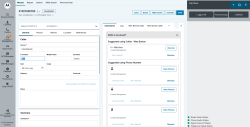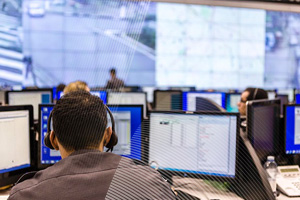Emergency calls don’t occur in a vacuum. Vulnerable callers — particularly victims of domestic violence and antisocial behaviour — may try to contact the emergency services multiple times over the course of their abuse. But if a call doesn’t end in a police officer being on-scene, it may not be recorded in a Force’s CAD or RMS, which means operators may not be aware of that historic information when the victim makes calls in the future. In some forces, such ‘non-deployment’ calls may account for over half of all calls received by a control room, and yet no data is recorded or held. In this blog, we’ll examine the serious, real-world consequences that can arise from a lack of previous data, and how technology can equip operators with the tools they need to gather and understand this context.
Missing crucial context and warning signs
While many calls to 999 are isolated cases, certain kinds of crime are perpetrated repeatedly against one victim, and may result in multiple calls to the emergency services over a period of time. Although any one call may not raise alarm bells, the broader pattern often reveals repeated or escalating behaviour on behalf of the perpetrator that crucially, this pattern isn’t always visible to control room staff.
One such crime is antisocial behaviour, defined as “behaviour by a person which causes, or is likely to cause, harassment, alarm or distress to persons not of the same household as the person.” Compounding this issue is the fact that anti-social behaviour is often aimed at individuals who are already deemed vulnerable. Single mother Fiona Pilkington took her own life and the life of her disabled daughter Francecca Hardwick in 2007 after enduring repeated antisocial behaviour over the course of a decade. She had been in communication with her local police force 33 times in the run-up to her death. Similarly, disabled Iranian refugee Bijan Ebrahimi was subjected to racist abuse for years before he was killed by his neighbour – he had called the police multiple times in the 48 hours before his murder. The family of David Askew, a man with learning difficulties, had contacted the police 88 times in six years concerning antisocial behaviour towards him.
Another kind of crime which may occur over a longer timeframe is that of domestic violence – in fact, according to the charity Refuge, “The police receive a domestic abuse-related call every 30 seconds.” Worryingly, the charity Victim Support reports that, “Over half of all respondents (53%) reported an instance of domestic abuse at least twice before they felt appropriate action was taken by the police.” In one particularly tragic example, 22 year old Raneem Oudeh and her mother Khaola Saleem were killed by Raneem’s abusive ex-husband in 2018: at the time of her murder, 13 separate reports had been made to police with concerns for her welfare, and she had called 999 four times on the night itself. In a similar case, Daniela Espirito Santo was killed by her partner while on hold with the police — she, too, had called 999 multiple times before her death.
These cases have not gone unnoticed. In their extensive report on the effect of antisocial behaviour on its victims, the Victims Commissioner describes the issue as follows: “[agencies] treated occurrences as one-off incidents rather than an ongoing pattern of behaviour that had the potential to escalate and needed addressing.” Similarly, HMICFRS stressed in their report on domestic violence that, “Forces need to identify repeat victims as early as possible. Doing so should help them to recognise patterns of abuse. This is particularly important in cases where a single incident might not appear to be serious, but where previous reports show a pattern of behaviour”.
Providing more context to control room operators
The problem is clear: Forces need better information about who is calling their control room, and how often. The question is, how can Forces equip their operators with the vital context they need to identify risk and vulnerable members of their community before a situation escalates into tragedy? And given the high rate of burnout among control room staff, how can forces introduce this context without also adding to their team’s workload by requiring them to search multiple, disparate databases?
As previously mentioned, some Computer-Aided Dispatch (CAD) systems have built-in contact management tools to capture previous deployments. However, if a call doesn’t result in deployment – because it was deemed low priority, or because the victim was afraid of their abuser’s potential response to police attendance – this vital information is essentially lost.
We aim to solve this problem by building contact management directly into Guardian ICCS itself. When a call comes in, information about the caller – such as name, number and location, where available – is automatically logged and linked to previous instances of contact on the system, regardless of the incident’s eventual deployment status. Once the caller has been identified, information from CAD, RMS and Police National Computer (PNC) databases is also shown in the same tab. Operators can quickly view all of this context on one screen, and access commonly-used proformas to ensure consistency of response. These proformas are logged against the call, for supervisors to review if necessary. Finally, operators can transfer the contact record back to their CAD or RMS (as a crime or intelligence report) in one click if needed. That means, in addition to assessing risk more accurately during the call, operators can forward the relevant data to other systems in case further action is needed – without requiring double-keying, and therefore risking database errors.

Built-in contact management offers a crucial solution to a systemic issue. By providing control room operators with immediate access to a caller’s history while on the call itself, and enabling the same operators to disseminate it easily, Forces can simultaneously provide more appropriate responses in the moment while also gathering important data for long-term intervention (such as proactively identifying repeat callers) – all without increasing their operators’ workloads.




